CX506001 Leadership Report: Practical Endeavour & Development Plan
VerifiedAdded on 2022/10/02
|7
|1614
|168
Report
AI Summary
This report examines a student's practical leadership endeavour within a Malaysian restaurant setting, focusing on implementing a quality plan and addressing quality issues. The report highlights the importance of effective communication, setting a clear vision, and utilizing an appropriate leadership style, specifically a democratic approach, for successful change management. It details the student's strengths in leading change and areas for improvement, such as maintaining positivity during change processes. Furthermore, the report discusses the broader roles of leadership in organizational success, including employee motivation, integrity, and morale-building, referencing various academic sources to support its analysis. The successful implementation of the quality plan and the elimination of quality issues within the organization were used to establish the success of the change.
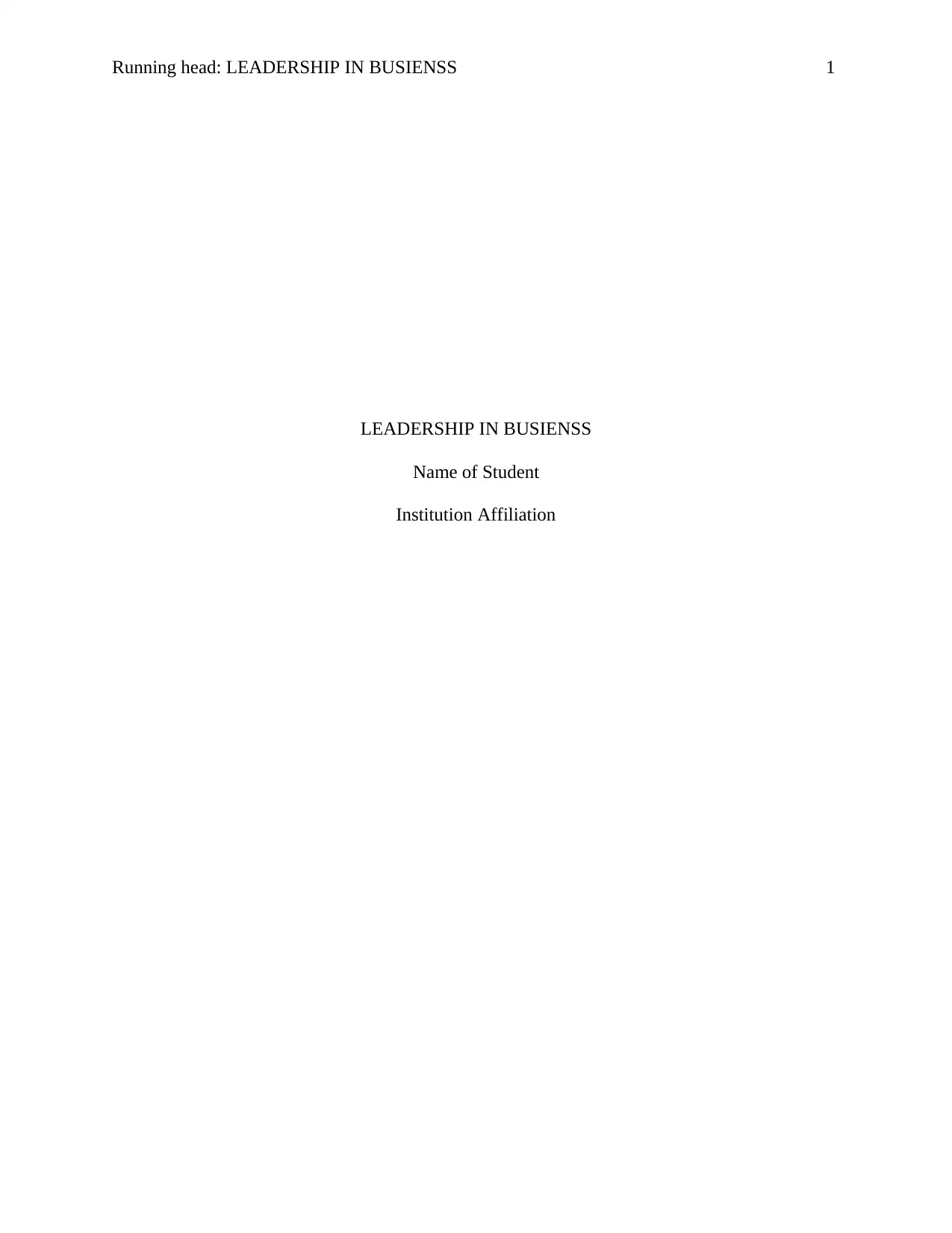
Running head: LEADERSHIP IN BUSIENSS 1
LEADERSHIP IN BUSIENSS
Name of Student
Institution Affiliation
LEADERSHIP IN BUSIENSS
Name of Student
Institution Affiliation
Paraphrase This Document
Need a fresh take? Get an instant paraphrase of this document with our AI Paraphraser
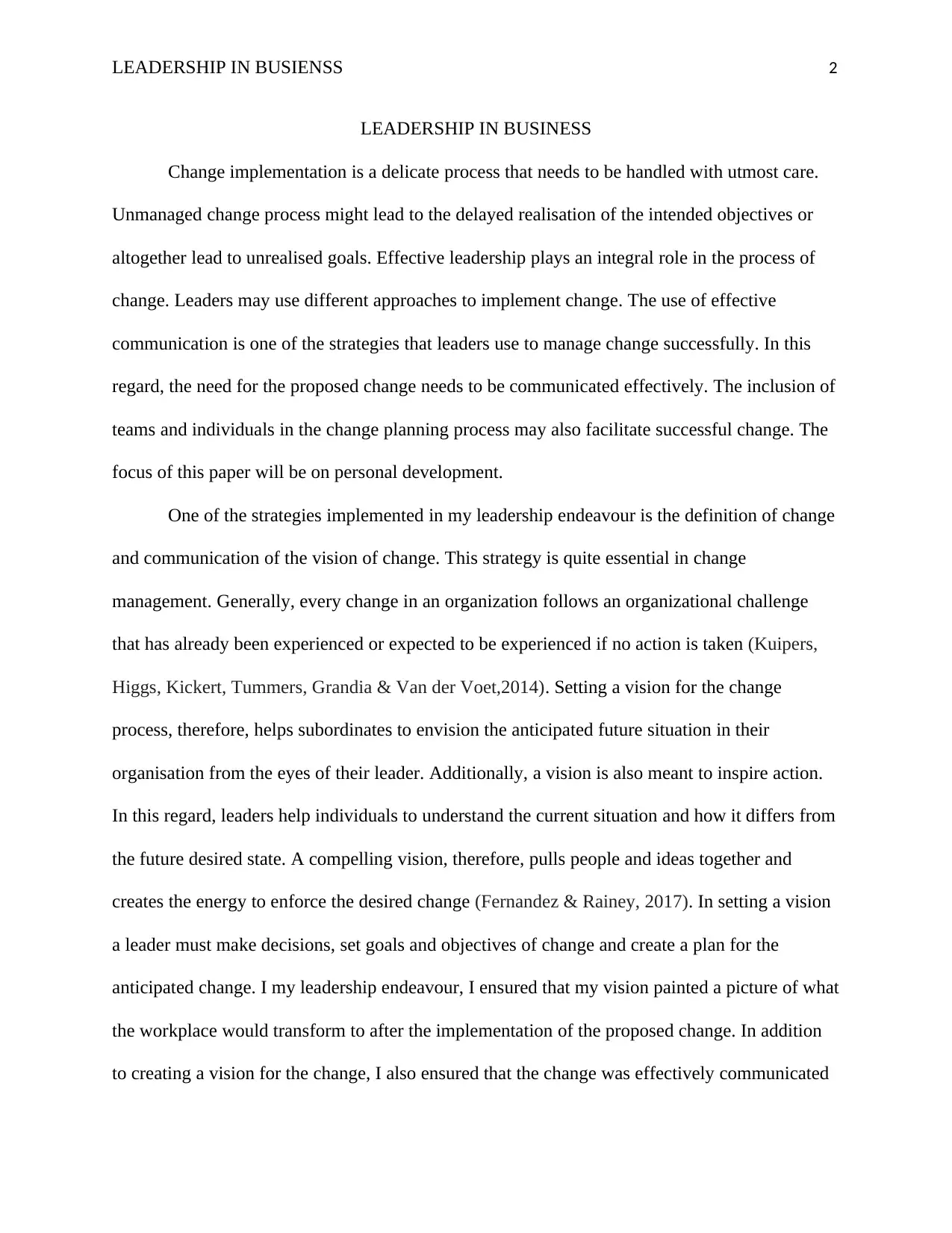
LEADERSHIP IN BUSIENSS 2
LEADERSHIP IN BUSINESS
Change implementation is a delicate process that needs to be handled with utmost care.
Unmanaged change process might lead to the delayed realisation of the intended objectives or
altogether lead to unrealised goals. Effective leadership plays an integral role in the process of
change. Leaders may use different approaches to implement change. The use of effective
communication is one of the strategies that leaders use to manage change successfully. In this
regard, the need for the proposed change needs to be communicated effectively. The inclusion of
teams and individuals in the change planning process may also facilitate successful change. The
focus of this paper will be on personal development.
One of the strategies implemented in my leadership endeavour is the definition of change
and communication of the vision of change. This strategy is quite essential in change
management. Generally, every change in an organization follows an organizational challenge
that has already been experienced or expected to be experienced if no action is taken (Kuipers,
Higgs, Kickert, Tummers, Grandia & Van der Voet,2014). Setting a vision for the change
process, therefore, helps subordinates to envision the anticipated future situation in their
organisation from the eyes of their leader. Additionally, a vision is also meant to inspire action.
In this regard, leaders help individuals to understand the current situation and how it differs from
the future desired state. A compelling vision, therefore, pulls people and ideas together and
creates the energy to enforce the desired change (Fernandez & Rainey, 2017). In setting a vision
a leader must make decisions, set goals and objectives of change and create a plan for the
anticipated change. I my leadership endeavour, I ensured that my vision painted a picture of what
the workplace would transform to after the implementation of the proposed change. In addition
to creating a vision for the change, I also ensured that the change was effectively communicated
LEADERSHIP IN BUSINESS
Change implementation is a delicate process that needs to be handled with utmost care.
Unmanaged change process might lead to the delayed realisation of the intended objectives or
altogether lead to unrealised goals. Effective leadership plays an integral role in the process of
change. Leaders may use different approaches to implement change. The use of effective
communication is one of the strategies that leaders use to manage change successfully. In this
regard, the need for the proposed change needs to be communicated effectively. The inclusion of
teams and individuals in the change planning process may also facilitate successful change. The
focus of this paper will be on personal development.
One of the strategies implemented in my leadership endeavour is the definition of change
and communication of the vision of change. This strategy is quite essential in change
management. Generally, every change in an organization follows an organizational challenge
that has already been experienced or expected to be experienced if no action is taken (Kuipers,
Higgs, Kickert, Tummers, Grandia & Van der Voet,2014). Setting a vision for the change
process, therefore, helps subordinates to envision the anticipated future situation in their
organisation from the eyes of their leader. Additionally, a vision is also meant to inspire action.
In this regard, leaders help individuals to understand the current situation and how it differs from
the future desired state. A compelling vision, therefore, pulls people and ideas together and
creates the energy to enforce the desired change (Fernandez & Rainey, 2017). In setting a vision
a leader must make decisions, set goals and objectives of change and create a plan for the
anticipated change. I my leadership endeavour, I ensured that my vision painted a picture of what
the workplace would transform to after the implementation of the proposed change. In addition
to creating a vision for the change, I also ensured that the change was effectively communicated
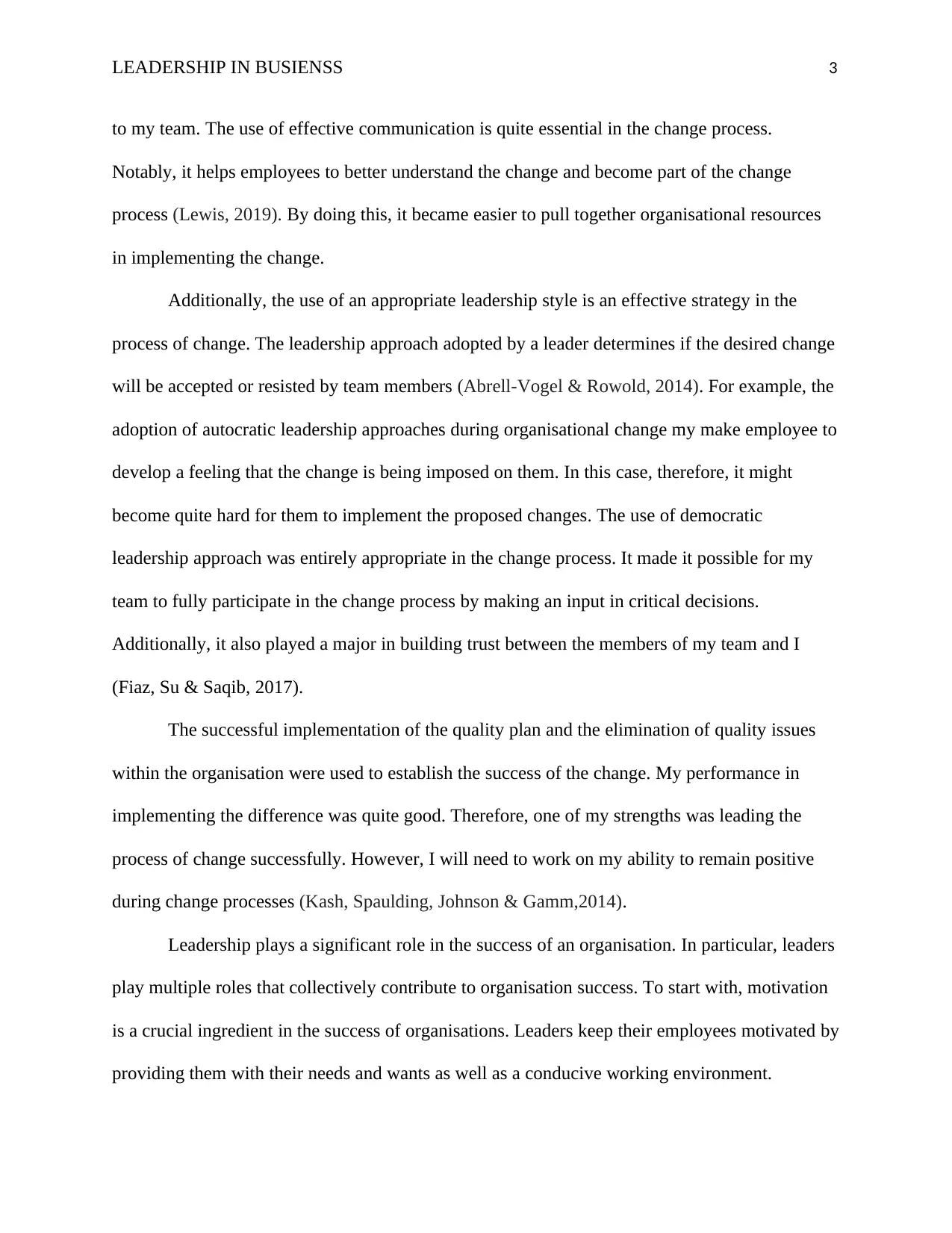
LEADERSHIP IN BUSIENSS 3
to my team. The use of effective communication is quite essential in the change process.
Notably, it helps employees to better understand the change and become part of the change
process (Lewis, 2019). By doing this, it became easier to pull together organisational resources
in implementing the change.
Additionally, the use of an appropriate leadership style is an effective strategy in the
process of change. The leadership approach adopted by a leader determines if the desired change
will be accepted or resisted by team members (Abrell-Vogel & Rowold, 2014). For example, the
adoption of autocratic leadership approaches during organisational change my make employee to
develop a feeling that the change is being imposed on them. In this case, therefore, it might
become quite hard for them to implement the proposed changes. The use of democratic
leadership approach was entirely appropriate in the change process. It made it possible for my
team to fully participate in the change process by making an input in critical decisions.
Additionally, it also played a major in building trust between the members of my team and I
(Fiaz, Su & Saqib, 2017).
The successful implementation of the quality plan and the elimination of quality issues
within the organisation were used to establish the success of the change. My performance in
implementing the difference was quite good. Therefore, one of my strengths was leading the
process of change successfully. However, I will need to work on my ability to remain positive
during change processes (Kash, Spaulding, Johnson & Gamm,2014).
Leadership plays a significant role in the success of an organisation. In particular, leaders
play multiple roles that collectively contribute to organisation success. To start with, motivation
is a crucial ingredient in the success of organisations. Leaders keep their employees motivated by
providing them with their needs and wants as well as a conducive working environment.
to my team. The use of effective communication is quite essential in the change process.
Notably, it helps employees to better understand the change and become part of the change
process (Lewis, 2019). By doing this, it became easier to pull together organisational resources
in implementing the change.
Additionally, the use of an appropriate leadership style is an effective strategy in the
process of change. The leadership approach adopted by a leader determines if the desired change
will be accepted or resisted by team members (Abrell-Vogel & Rowold, 2014). For example, the
adoption of autocratic leadership approaches during organisational change my make employee to
develop a feeling that the change is being imposed on them. In this case, therefore, it might
become quite hard for them to implement the proposed changes. The use of democratic
leadership approach was entirely appropriate in the change process. It made it possible for my
team to fully participate in the change process by making an input in critical decisions.
Additionally, it also played a major in building trust between the members of my team and I
(Fiaz, Su & Saqib, 2017).
The successful implementation of the quality plan and the elimination of quality issues
within the organisation were used to establish the success of the change. My performance in
implementing the difference was quite good. Therefore, one of my strengths was leading the
process of change successfully. However, I will need to work on my ability to remain positive
during change processes (Kash, Spaulding, Johnson & Gamm,2014).
Leadership plays a significant role in the success of an organisation. In particular, leaders
play multiple roles that collectively contribute to organisation success. To start with, motivation
is a crucial ingredient in the success of organisations. Leaders keep their employees motivated by
providing them with their needs and wants as well as a conducive working environment.
⊘ This is a preview!⊘
Do you want full access?
Subscribe today to unlock all pages.

Trusted by 1+ million students worldwide
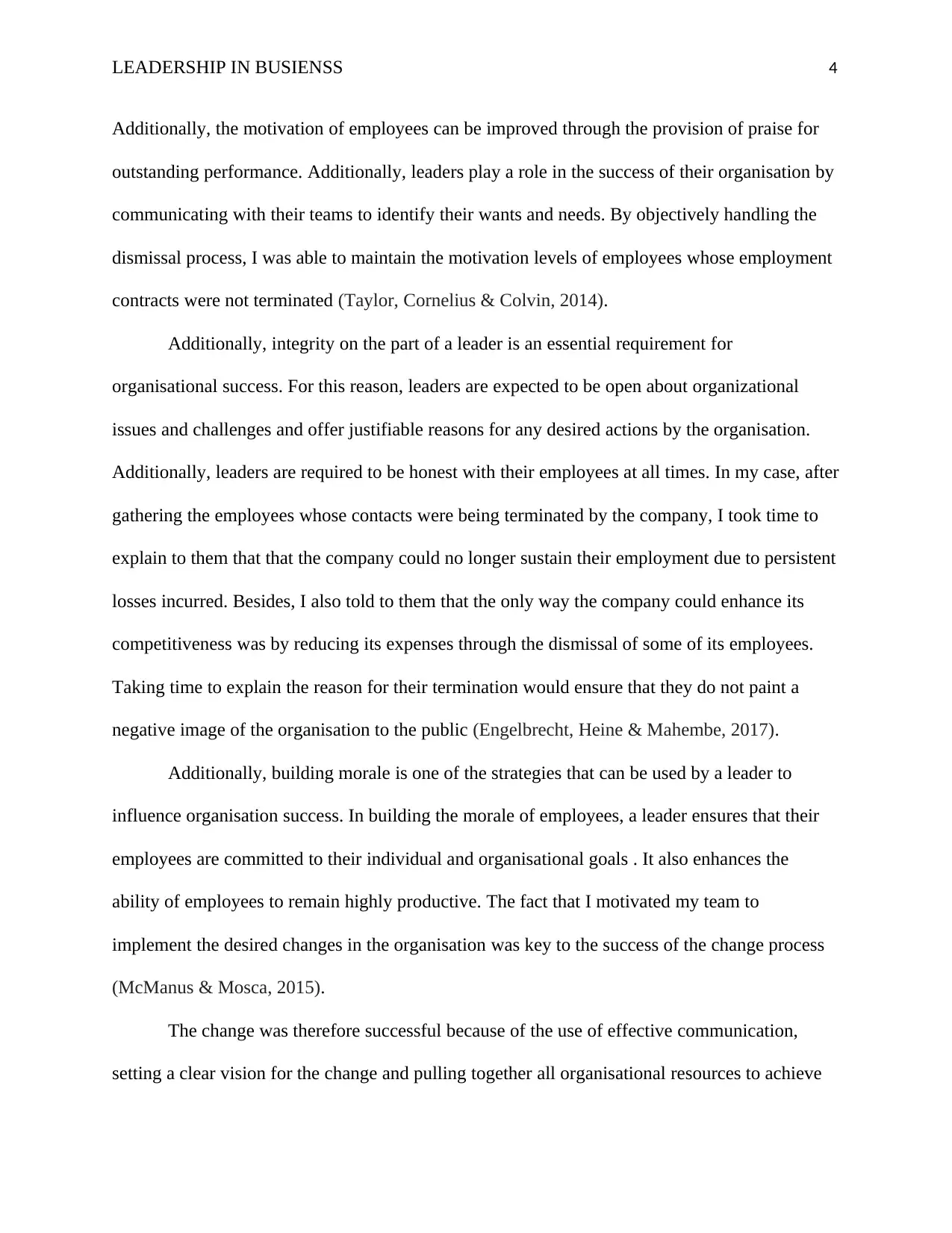
LEADERSHIP IN BUSIENSS 4
Additionally, the motivation of employees can be improved through the provision of praise for
outstanding performance. Additionally, leaders play a role in the success of their organisation by
communicating with their teams to identify their wants and needs. By objectively handling the
dismissal process, I was able to maintain the motivation levels of employees whose employment
contracts were not terminated (Taylor, Cornelius & Colvin, 2014).
Additionally, integrity on the part of a leader is an essential requirement for
organisational success. For this reason, leaders are expected to be open about organizational
issues and challenges and offer justifiable reasons for any desired actions by the organisation.
Additionally, leaders are required to be honest with their employees at all times. In my case, after
gathering the employees whose contacts were being terminated by the company, I took time to
explain to them that that the company could no longer sustain their employment due to persistent
losses incurred. Besides, I also told to them that the only way the company could enhance its
competitiveness was by reducing its expenses through the dismissal of some of its employees.
Taking time to explain the reason for their termination would ensure that they do not paint a
negative image of the organisation to the public (Engelbrecht, Heine & Mahembe, 2017).
Additionally, building morale is one of the strategies that can be used by a leader to
influence organisation success. In building the morale of employees, a leader ensures that their
employees are committed to their individual and organisational goals . It also enhances the
ability of employees to remain highly productive. The fact that I motivated my team to
implement the desired changes in the organisation was key to the success of the change process
(McManus & Mosca, 2015).
The change was therefore successful because of the use of effective communication,
setting a clear vision for the change and pulling together all organisational resources to achieve
Additionally, the motivation of employees can be improved through the provision of praise for
outstanding performance. Additionally, leaders play a role in the success of their organisation by
communicating with their teams to identify their wants and needs. By objectively handling the
dismissal process, I was able to maintain the motivation levels of employees whose employment
contracts were not terminated (Taylor, Cornelius & Colvin, 2014).
Additionally, integrity on the part of a leader is an essential requirement for
organisational success. For this reason, leaders are expected to be open about organizational
issues and challenges and offer justifiable reasons for any desired actions by the organisation.
Additionally, leaders are required to be honest with their employees at all times. In my case, after
gathering the employees whose contacts were being terminated by the company, I took time to
explain to them that that the company could no longer sustain their employment due to persistent
losses incurred. Besides, I also told to them that the only way the company could enhance its
competitiveness was by reducing its expenses through the dismissal of some of its employees.
Taking time to explain the reason for their termination would ensure that they do not paint a
negative image of the organisation to the public (Engelbrecht, Heine & Mahembe, 2017).
Additionally, building morale is one of the strategies that can be used by a leader to
influence organisation success. In building the morale of employees, a leader ensures that their
employees are committed to their individual and organisational goals . It also enhances the
ability of employees to remain highly productive. The fact that I motivated my team to
implement the desired changes in the organisation was key to the success of the change process
(McManus & Mosca, 2015).
The change was therefore successful because of the use of effective communication,
setting a clear vision for the change and pulling together all organisational resources to achieve
Paraphrase This Document
Need a fresh take? Get an instant paraphrase of this document with our AI Paraphraser
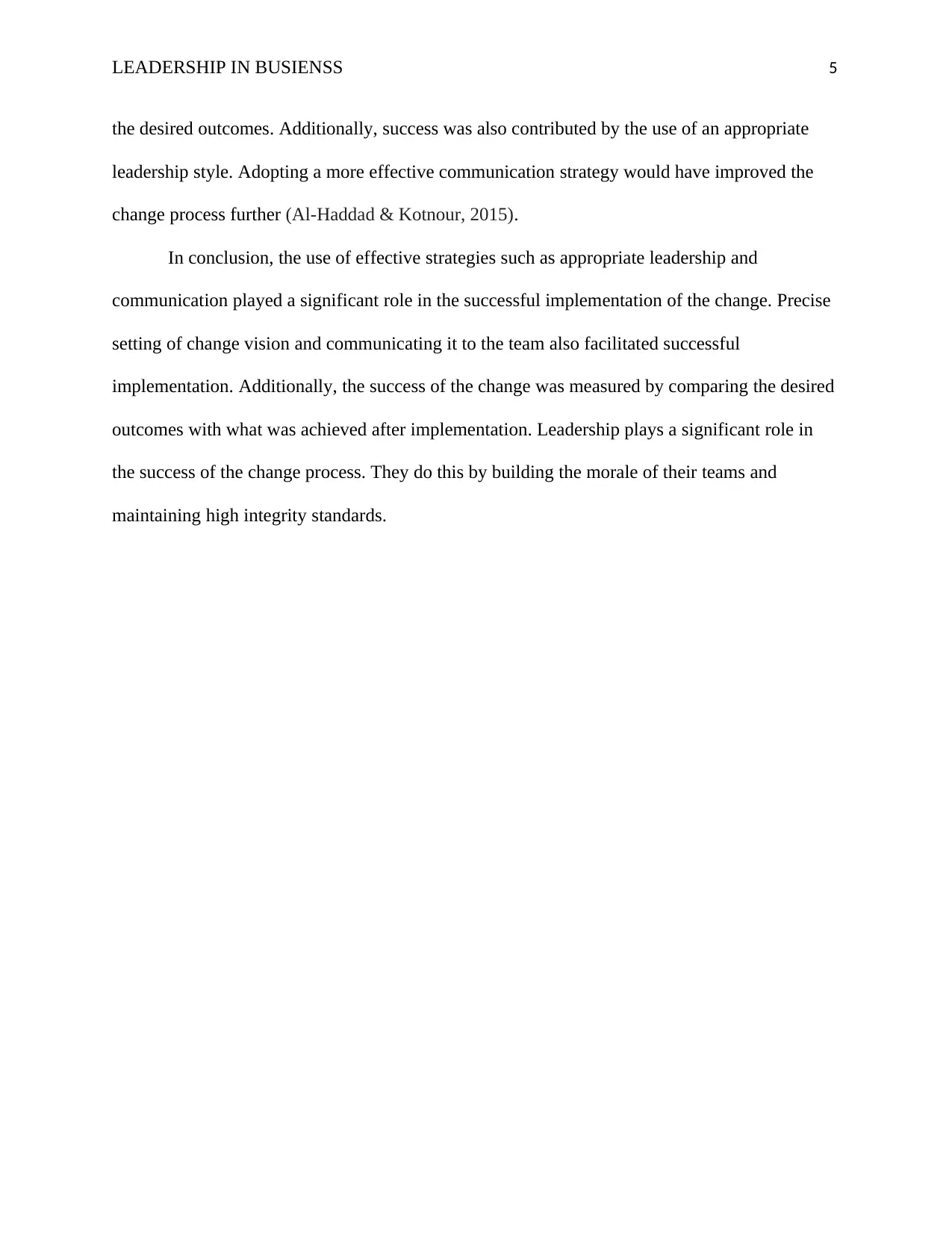
LEADERSHIP IN BUSIENSS 5
the desired outcomes. Additionally, success was also contributed by the use of an appropriate
leadership style. Adopting a more effective communication strategy would have improved the
change process further (Al-Haddad & Kotnour, 2015).
In conclusion, the use of effective strategies such as appropriate leadership and
communication played a significant role in the successful implementation of the change. Precise
setting of change vision and communicating it to the team also facilitated successful
implementation. Additionally, the success of the change was measured by comparing the desired
outcomes with what was achieved after implementation. Leadership plays a significant role in
the success of the change process. They do this by building the morale of their teams and
maintaining high integrity standards.
the desired outcomes. Additionally, success was also contributed by the use of an appropriate
leadership style. Adopting a more effective communication strategy would have improved the
change process further (Al-Haddad & Kotnour, 2015).
In conclusion, the use of effective strategies such as appropriate leadership and
communication played a significant role in the successful implementation of the change. Precise
setting of change vision and communicating it to the team also facilitated successful
implementation. Additionally, the success of the change was measured by comparing the desired
outcomes with what was achieved after implementation. Leadership plays a significant role in
the success of the change process. They do this by building the morale of their teams and
maintaining high integrity standards.
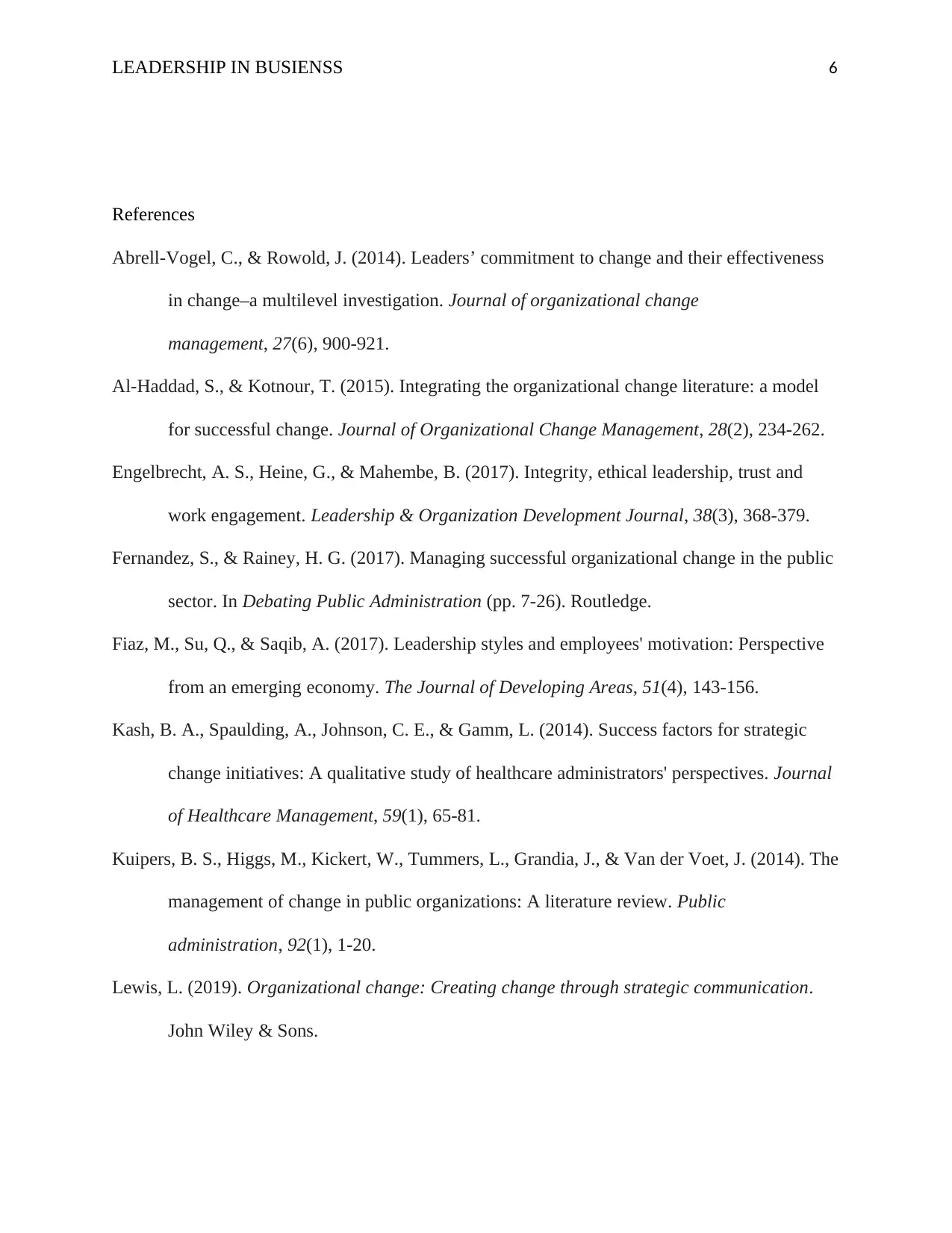
LEADERSHIP IN BUSIENSS 6
References
Abrell-Vogel, C., & Rowold, J. (2014). Leaders’ commitment to change and their effectiveness
in change–a multilevel investigation. Journal of organizational change
management, 27(6), 900-921.
Al-Haddad, S., & Kotnour, T. (2015). Integrating the organizational change literature: a model
for successful change. Journal of Organizational Change Management, 28(2), 234-262.
Engelbrecht, A. S., Heine, G., & Mahembe, B. (2017). Integrity, ethical leadership, trust and
work engagement. Leadership & Organization Development Journal, 38(3), 368-379.
Fernandez, S., & Rainey, H. G. (2017). Managing successful organizational change in the public
sector. In Debating Public Administration (pp. 7-26). Routledge.
Fiaz, M., Su, Q., & Saqib, A. (2017). Leadership styles and employees' motivation: Perspective
from an emerging economy. The Journal of Developing Areas, 51(4), 143-156.
Kash, B. A., Spaulding, A., Johnson, C. E., & Gamm, L. (2014). Success factors for strategic
change initiatives: A qualitative study of healthcare administrators' perspectives. Journal
of Healthcare Management, 59(1), 65-81.
Kuipers, B. S., Higgs, M., Kickert, W., Tummers, L., Grandia, J., & Van der Voet, J. (2014). The
management of change in public organizations: A literature review. Public
administration, 92(1), 1-20.
Lewis, L. (2019). Organizational change: Creating change through strategic communication.
John Wiley & Sons.
References
Abrell-Vogel, C., & Rowold, J. (2014). Leaders’ commitment to change and their effectiveness
in change–a multilevel investigation. Journal of organizational change
management, 27(6), 900-921.
Al-Haddad, S., & Kotnour, T. (2015). Integrating the organizational change literature: a model
for successful change. Journal of Organizational Change Management, 28(2), 234-262.
Engelbrecht, A. S., Heine, G., & Mahembe, B. (2017). Integrity, ethical leadership, trust and
work engagement. Leadership & Organization Development Journal, 38(3), 368-379.
Fernandez, S., & Rainey, H. G. (2017). Managing successful organizational change in the public
sector. In Debating Public Administration (pp. 7-26). Routledge.
Fiaz, M., Su, Q., & Saqib, A. (2017). Leadership styles and employees' motivation: Perspective
from an emerging economy. The Journal of Developing Areas, 51(4), 143-156.
Kash, B. A., Spaulding, A., Johnson, C. E., & Gamm, L. (2014). Success factors for strategic
change initiatives: A qualitative study of healthcare administrators' perspectives. Journal
of Healthcare Management, 59(1), 65-81.
Kuipers, B. S., Higgs, M., Kickert, W., Tummers, L., Grandia, J., & Van der Voet, J. (2014). The
management of change in public organizations: A literature review. Public
administration, 92(1), 1-20.
Lewis, L. (2019). Organizational change: Creating change through strategic communication.
John Wiley & Sons.
⊘ This is a preview!⊘
Do you want full access?
Subscribe today to unlock all pages.

Trusted by 1+ million students worldwide
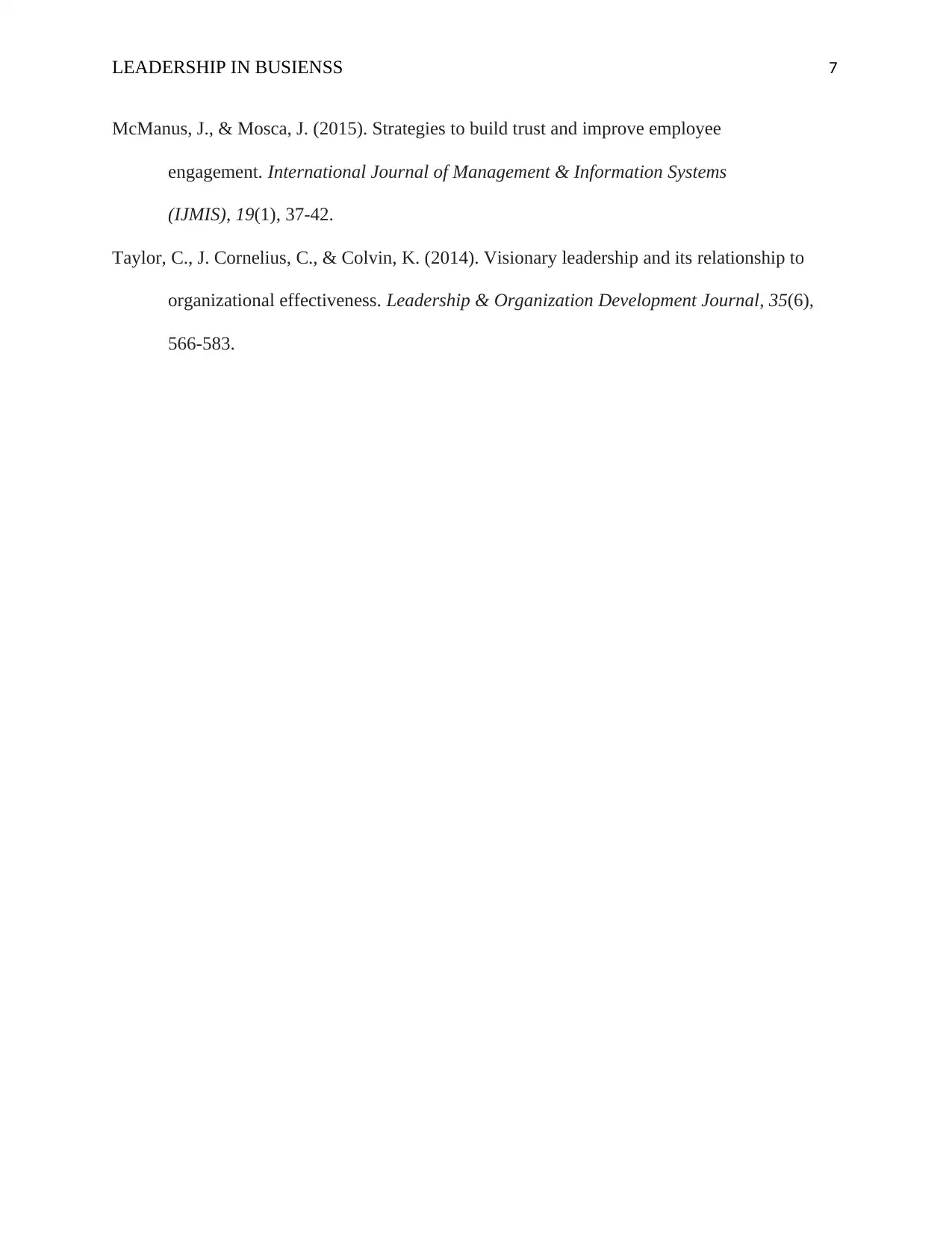
LEADERSHIP IN BUSIENSS 7
McManus, J., & Mosca, J. (2015). Strategies to build trust and improve employee
engagement. International Journal of Management & Information Systems
(IJMIS), 19(1), 37-42.
Taylor, C., J. Cornelius, C., & Colvin, K. (2014). Visionary leadership and its relationship to
organizational effectiveness. Leadership & Organization Development Journal, 35(6),
566-583.
McManus, J., & Mosca, J. (2015). Strategies to build trust and improve employee
engagement. International Journal of Management & Information Systems
(IJMIS), 19(1), 37-42.
Taylor, C., J. Cornelius, C., & Colvin, K. (2014). Visionary leadership and its relationship to
organizational effectiveness. Leadership & Organization Development Journal, 35(6),
566-583.
1 out of 7
Related Documents
Your All-in-One AI-Powered Toolkit for Academic Success.
+13062052269
info@desklib.com
Available 24*7 on WhatsApp / Email
![[object Object]](/_next/static/media/star-bottom.7253800d.svg)
Unlock your academic potential
Copyright © 2020–2025 A2Z Services. All Rights Reserved. Developed and managed by ZUCOL.





